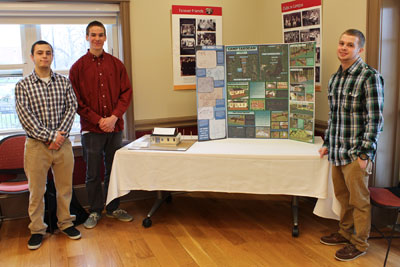Students Lend a Hand to Camp Takodah

Full of fun and felicity in the summer, Camp Takodah in Richmond, NH, can be a pretty desolate and dreary place in the winter. But that didn’t stop Keene State juniors Korey Lubinger, Evan Sage, and Brendan Spina from bundling up their gear and heading to the YMCA camp, which will celebrate its 100th anniversary next year.
The three Keene State students also had the future of the camp in mind as they trudged through the snow and ice on a frigid Friday afternoon last February. The trio was getting the lay of the land for their Collaborative Architectural Project class, an architecture course that’s also known as Communicorps. Their project: helping Camp Takodah develop unused areas of its property to create facilities that would attract more campers.
“When we went out to the camp we got a whole different picture on what we were working with because we had only seen topography maps and site pictures,” said Brendan Spina of Bristol, RI.
The development of Camp Takodah is the latest in a series of projects in the Communicorps program, which was started by Keene State architecture professor Peter Temple in the 1990s. The semester-long group projects provide students with the opportunity of using architecture skills to help nonprofits and community organizations. “The idea is to get students the experience working on something real, a real site and a real client,” said Temple, who has been at the College since 1991. “They begin to see how the field of architecture and building professions can have a good impact on the community if it’s done in the right way.”
Over the years, Communicorps projects have included affordable and transitional housing, a fire station, and a community center. Temple, who had done some previous work for Camp Takodah, was excited to help the Cheshire County YMCA camp update its master plan and develop acres of unused land.
Given the option of five different projects, Lubinger, Sage, and Spina jumped at the opportunity to extend and revitalize Camp Takodah’s footprint. “We usually work with traditional houses in class, so I thought it would be cool to work on something totally different,” said Spina. “When you’re out in the field you’re not always going to be doing the same project.”
The three students had a tall task. Despite having about 500 acres, Camp Takodah, which was started in 1916, is utilizing just a small portion (50-60 acres) of its land. Looking forward to the collaboration, the Y staff, which includes Executive Director Scott Peckins and Camping Service Director Ryan Reed, met with the students, relaying the camp’s mission and determining the prospects for property enhancement and what activities were suitable for the land.
Meeting on a regular basis throughout the semester, the group decided that Davis Field, an area away from the main camp site and on the other side of Cass Pond, had the best potential for development. They came up with several appealing ideas ranging from treehouse cabins with zip lines all the way down to the less-appealing but environmentally sound compost toilets. “Everyone had their own ideas about what would be cool,” said Lubinger, who hails from Pelham. “We came up with ideas and then talked with the clients and they’d tell us what was reasonable. We came up with some off-the-wall things like a paintball course, but they discouraged that.”
Temple said the project was a good learning experience for the students, teaching them how to interact with many constituents like wetlands inspectors and people at city hall as well as members of their own group.
“It was tough, but it was a good learning experience because I never had to actually count on other people to do their part,” said Sage, a native of Pelham. “If they don’t do their part, you have to step up and take their role. As a group we managed to figure out ways to work with each other’s schedules and it ended up working out.”
Peckins was very pleased with the final design by the students, who not only gave the camp some great ideas, but also presented the Y with actual blueprints of the proposed structures so they can move forward with them. “I think the students had a real good time and came up with some interesting and intriguing ideas for us,” said Peckins, who is set to start his fifth year with the organization. “It was a learning experience for both of us – one that we’d like to continue.”
Taking into account finances and priorities set by the Y’s board of directors, Peckins feels that several of the projects like the treehouse cabins could come to fruition in the near future.
“That’s the most exciting part of all of it – knowing that something you designed and created could actually be built,” said Sage. “This project was really moving for me and helped me decide what I wanted to do for the future,” he added. “It was a good first experience and gave me an idea of what architecture is all about.”
Temple has several Communicorps projects on the drawing board. He is working with Southwest Community Services to develop transitional and affordable housing for veterans in Keene and has put the wheels in motion to begin the transformation of Troy Mills into a sustainable food center. Temple also has his eyes on several international projects. He is planning to travel to Haiti with several Keene State students next winter to work on developing a vocational school.





